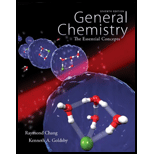
(a)
Interpretation:
In accordance with the given conditions the residual entropy in the
Concept Introduction:
Entropy is the measure of randomness in the system. According to the third law of
A thermodynamic system can have degenerate and non-degenerate energy levels. There can be different possible arrangements of the particles in the various energy levels. These possible arrangements are defined as thermodynamic probability
Where,
The entropy and thermodynamic probability is related by Boltzmann equation. As the number of possible arrangements increases the entropy also increases.
Where,
(b)
Interpretation:
In accordance with the given conditions the residual entropy in the
Concept Introduction:
Entropy is the measure of randomness in the system. According to the third law of thermodynamics entropy of a perfectly crystalline substance at zero Kelvin is zero. The substances which are not perfectly crystalline, possess entropy even at zero Kelvin. The entropy of a substance at zero Kelvin is known as residual entropy.
A thermodynamic system can have degenerate and non-degenerate energy levels. There can be different possible arrangements of the particles in the various energy levels. These possible arrangements are defined as thermodynamic probability
Where,
The entropy and thermodynamic probability is related by Boltzmann equation. As the number of possible arrangements increases the entropy also increases.
Where,
Want to see the full answer?
Check out a sample textbook solution
Chapter 18 Solutions
Connect 2-Year Access Card for Chemistry: The Essential Concepts
 ChemistryChemistryISBN:9781305957404Author:Steven S. Zumdahl, Susan A. Zumdahl, Donald J. DeCostePublisher:Cengage Learning
ChemistryChemistryISBN:9781305957404Author:Steven S. Zumdahl, Susan A. Zumdahl, Donald J. DeCostePublisher:Cengage Learning ChemistryChemistryISBN:9781259911156Author:Raymond Chang Dr., Jason Overby ProfessorPublisher:McGraw-Hill Education
ChemistryChemistryISBN:9781259911156Author:Raymond Chang Dr., Jason Overby ProfessorPublisher:McGraw-Hill Education Principles of Instrumental AnalysisChemistryISBN:9781305577213Author:Douglas A. Skoog, F. James Holler, Stanley R. CrouchPublisher:Cengage Learning
Principles of Instrumental AnalysisChemistryISBN:9781305577213Author:Douglas A. Skoog, F. James Holler, Stanley R. CrouchPublisher:Cengage Learning Organic ChemistryChemistryISBN:9780078021558Author:Janice Gorzynski Smith Dr.Publisher:McGraw-Hill Education
Organic ChemistryChemistryISBN:9780078021558Author:Janice Gorzynski Smith Dr.Publisher:McGraw-Hill Education Chemistry: Principles and ReactionsChemistryISBN:9781305079373Author:William L. Masterton, Cecile N. HurleyPublisher:Cengage Learning
Chemistry: Principles and ReactionsChemistryISBN:9781305079373Author:William L. Masterton, Cecile N. HurleyPublisher:Cengage Learning Elementary Principles of Chemical Processes, Bind...ChemistryISBN:9781118431221Author:Richard M. Felder, Ronald W. Rousseau, Lisa G. BullardPublisher:WILEY
Elementary Principles of Chemical Processes, Bind...ChemistryISBN:9781118431221Author:Richard M. Felder, Ronald W. Rousseau, Lisa G. BullardPublisher:WILEY





